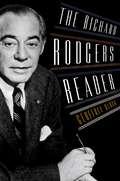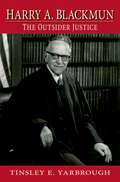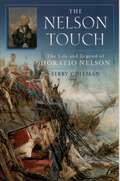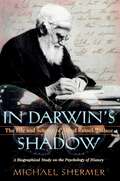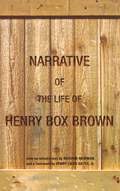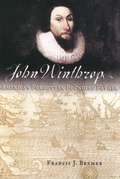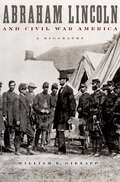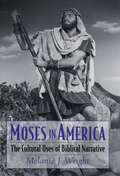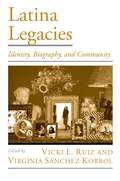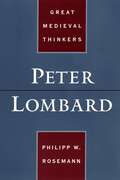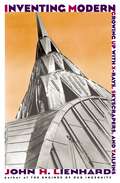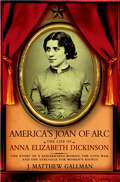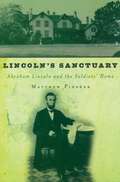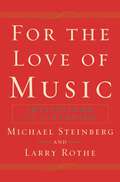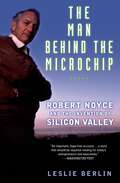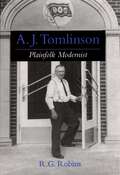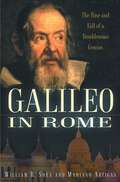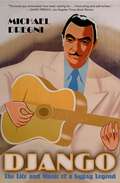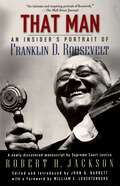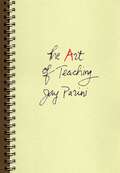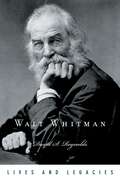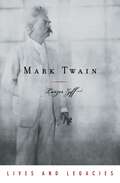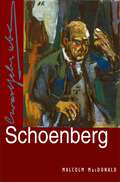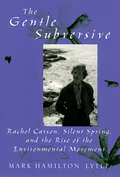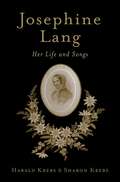- Table View
- List View
The Richard Rodgers Reader (Readers on American Musicians)
by Geoffrey BlockRichard Rodgers was one of America's most prolific and best-loved composers. A world without "My Funny Valentine," "The Lady is a Tramp," "Blue Moon," and "Bewitched," to name just a few of the songs he wrote with Lorenz Hart, is scarcely imaginable, and the musicals he wrote with his second collaborator, Oscar Hammerstein--Oklahoma!, Carousel, South Pacific, The King and I, and The Sound of Music--continue to enchant and entertain audiences. Arranged in four sections, Rodgers and Hart (1929-1943), Rodgers and Hammerstein (1943-1960), Rodgers After Hammerstein (1960-1979), and The Composer Speaks (1939-1971), The Richard Rodgers Reader offers a cornucopia of informative, perceptive, and stylish biographical and critical overviews. It also contains a selection of Rodgers's letters to his wife Dorothy in the 1920s, the 1938 Time magazine cover story and New Yorker profiles in 1938 and 1961, and essays and reviews by such noted critics as Brooks Atkinson, Eric Bentley, Leonard Bernstein, Lehman Engel, Walter Kerr, Ken Mandelbaum, Ethan Mordden, George Jean Nathan, and Alec Wilder. The volume features personal accounts by Richard Adler, Agnes de Mille, Joshua Logan, Mary Martin, and Diahann Carroll. The collection concludes with complete selections from more than thirty years of Rodgers's own writings on topics ranging from the creative process, the state of the Broadway theater, even Rodgers's bout with cancer, and a generous sample from the candid and previously unpublished Columbia University interviews. For anyone wishing to explore more fully the life and work of a composer whose songs and musicals have assumed a permanent--and prominent--place in American popular culture, The Richard Rodgers Reader will offer endless delights.
Harry A. Blackmun: The Outsider Justice
by Tinsley YarbroughWhen appointed to the Supreme Court in 1970 by President Nixon, Harry A. Blackmun was seen as a quiet, safe choice to complement the increasingly conservative Court of his boyhood friend, Warren Burger. No one anticipated his seminal opinion championing abortion rights in Roe v. Wade, the most controversial ruling of his generation, which became the battle cry of both supporters and critics of judicial power and made Blackmun a liberal icon. Harry A. Blackmun: The Outsider Justice is Tinsley E. Yarbrough's penetrating account of one of the most outspoken and complicated figures on the Supreme Court. As a justice, Blackmun stood at the pinnacle of the American judiciary. Yet when he took his seat on the Court, Justice Blackmun felt "almost desperate," overwhelmed with feelings of self-doubt and inadequacy over the immense responsibilities before him. Blackmun had overcome humble roots to achieve a Harvard education, success as a Minneapolis lawyer and resident counsel to the prestigious Mayo Clinic, as well as a distinguished record on the Eighth Circuit federal appeals court. But growing up in a financially unstable home with a frequently unemployed father and an emotionally fragile mother left a permanent mark on the future justice. All his life, Harry Blackmun considered himself one of society's outsiders, someone who did not "belong." Remarkably, though, that very self-image instilled in the justice, throughout his career, a deep empathy for society's most vulnerable outsiders--women faced with unwanted pregnancies, homosexuals subjected to archaic laws, and ultimately, death-row inmates. To those who saw his career as the constitutional odyssey of a conservative jurist gradually transformed into a champion of the underdog, Blackmun had a ready answer: he had not changed; the Court and the issues before them changed. The justice's identification with the marginalized members of society arguably provides the overarching key to that consistency. Thoroughly researched, engagingly written, Harry A. Blackmun: The Outsider Justice offers an in-depth, revelatory portrait of one of the most intriguing jurists ever to sit on the Supreme Court. Relying on in-depth archival material, in addition to numerous interviews with Blackmun's former clerks, Yarbrough here presents the definitive biography of the great justice, ultimately providing an illuminating window into the inner-workings of the modern Supreme Court.
In Darwin's Shadow: The Life and Science of Alfred Russel Wallace: A Biographical Study on the Psychology of History
by Michael ShermerVirtually unknown today, Alfred Russel Wallace was the co-discoverer of natural selection with Charles Darwin and an eminent scientist who stood out among his Victorian peers as a man of formidable mind and equally outsized personality. Now Michael Shermer rescues Wallace from the shadow of Darwin in this landmark biography. Here we see Wallace as perhaps the greatest naturalist of his age--spending years in remote jungles, collecting astounding quantities of specimens, writing thoughtfully and with bemused detachment at his reception in places where no white man had ever gone. Here, too, is his supple and forceful intelligence at work, grappling with such arcane problems as the bright coloration of caterpillars, or shaping his 1858 paper on natural selection that prompted Darwin to publish (with Wallace) the first paper outlining the theory of evolution. Shermer also shows that Wallace's self-trained intellect, while powerful, also embraced surprisingly naive ideas, such as his deep interest in the study of spiritual manifestations and seances. Shermer shows that the same iconoclastic outlook that led him to overturn scientific orthodoxy as he worked in relative isolation also led him to embrace irrational beliefs, and thus tarnish his reputation. As author of Why People Believe Weird Things and founding publisher of Skeptic magazine, Shermer is an authority on why people embrace the irrational. Now he turns his keen judgment and incisive analysis to Wallace's life and his contradictory beliefs, restoring a leading figure in the rise of modern science to his rightful place.
Narrative of the Life of Henry Box Brown
by Henry Box BrownIn 1849, Henry Brown escaped from slavery by shipping himself in a three-foot-by-two-foot wooden crate from Virginia to an anti-slavery office in Philadelphia. Twenty-seven hours and 350 miles later, Brown stepped out of his box to begin a new life. This is his memoir, originally published in 1851 in England, as fresh and compelling today as it was 150 years ago. This extraordinary narrative paints an indelible portrait of life in slavery. With a keen sense of irony, Brown examines the "peculiar institution"--from the hypocrisy of slave-owning Christian preachers, to the system of bribery that forced slaves to purchase the rights to their own belongings, to the practice of separating slave families with no warning. The story also describes one of the most audacious, creative escapes ever completed. A classic slave narrative, it makes for unforgettable reading.
John Winthrop: America's Forgotten Founding Father
by Francis J. BremerJohn Winthrop's effort to create a Puritan "City on a Hill" has had a lasting effect on American values, and many remember this phrase famously quoted by the late Ronald Reagan. However, most know very little about the first American to speak these words. In John Winthrop, Francis J. Bremer draws on over a decade of research in England, Ireland, and the United States to offer a superb biography of the first governor of the Massachusetts Bay Colony, one rooted in a detailed understanding of his first forty years in England. Indeed, Bremer provides an extensive, path-breaking treatment of Winthrop's family background, youthful development, and English career. His dissatisfaction with the decline of the "godly kingdom of the Stour Valley" in which he had been raised led him on his errand to rebuild such a society in a New England. In America, Winthrop would use the skills he had developed in England as he struggled with challenges from Roger Williams and Anne Hutchinson, among others, and defended the colony from English interference. We also see the personal side of Winthrop--the doubts and concerns of the spiritual pilgrim, his everyday labors and pleasures, his feelings for family and friends. And Bremer also sheds much light on important historical moments in England and America, such as the Reformation and the rise of Puritanism, the rise of the middling class, the colonization movement, and colonial relations with Native Americans. Incorporating previously unexplored archival materials from both sides of the Atlantic, here is the definitive portrait of one of the giants of our history. John Winthrop recevied an honorable Mention, The Colonial Dames of America Book Award.
Abraham Lincoln and Civil War America: A Biography
by William E. GienappIn Abraham Lincoln and Civil War America, historian William Gienapp provides a remarkably concise, up-to-date, and vibrant biography of the most revered figure in United States history. While the heart of the book focuses on the Civil War, Gienapp begins with a finely etched portrait of Lincoln's early life, from pioneer farm boy to politician and lawyer in Springfield, to his stunning election as sixteenth president of the United States. Students will see how Lincoln grew during his years in office, how he developed a keen aptitude for military strategy and displayed enormous skill in dealing with his generals, and how his war strategy evolved from a desire to preserve the Union to emancipation and total war. Gienapp shows how Lincoln's early years influenced his skills as commander-in-chief and demonstrates that, throughout the stresses of the war years, Lincoln's basic character shone through: his good will and fundamental decency, his remarkable self-confidence matched with genuine humility, his immunity to the passions and hatreds the war spawned, his extraordinary patience, and his timeless devotion. A former backwoodsman and country lawyer, Abraham Lincoln rose to become one of our greatest presidents. This biography offers a vivid account of Lincoln's dramatic ascension to the pinnacle of American history.
Latina Legacies: Identity, Biography, and Community (Viewpoints on American Culture)
by Vicki L. Ruiz Virginia Sánchez KorrolSpanning two centuries, this collection documents the lives of fifteen remarkable Latinas who witnessed, defined, defied, and wrote about the forces that shaped their lives. As entrepreneurs, community activists, mystics, educators, feminists, labor organizers, artists and entertainers, Latinas used the power of the pen to traverse and transgress cultural conventions.
Peter Lombard (Great Medieval Thinkers)
by Philipp W. RosemannPeter Lombard is best known as the author of a celebrated work entitled Book of Sentences, which for several centuries served as the standard theological textbook in the Christian West. It was the subject of more commentaries than any other work of Christian literature besides the Bible itself. The Book of Sentences is essentially a compilation of older sources, from the Scriptures and Augustine down to several of the Lombard's contemporaries, such as Hugh of Saint Victor and Peter Abelard. Its importance lies in the Lombard's organization of the theological material, his method of presentation, and the way in which he shaped doctrine in several major areas. Despite his importance, however, there is no accessible introduction to Peter Lombard's life and thought available in any modern language. This volume fills this considerable gap. Philipp W. Rosemann begins by demonstrating how the Book of Sentences grew out of a long tradition of Christian reflection-a tradition, ultimately rooted in Scripture, which by the twelfth century had become ready to transform itself into a theological system. Turning to the Sentences, Rosemann then offers a brief exposition of the Lombard's life and work. He proceeds to a book-by-book examination and interpretation of its main topics, including the nature and attributes of God, the Trinity, creation, angelology, human nature and the Fall, original sin, Christology, ethics, and the sacraments. He concludes by exploring how the Sentences helped shape the further development of the Christian tradition, from the twelfth century through the time of Martin Luther.
Inventing Modern: Growing up with X-Rays, Skyscrapers, and Tailfins
by John H. LienhardModern is a word much used, but hard to pin down. In Inventing Modern, John H. Lienhard uses that word to capture the furious rush of newness in the first half of 20th-century America. An unexpected world emerges from under the more familiar Modern. Beyond the airplanes, radios, art deco, skyscrapers, Fritz Lang's Metropolis, Buck Rogers, the culture of the open road--Burma Shave, Kerouac, and White Castles--lie driving forces that set this account of Modern apart. One force, says Lienhard, was a new concept of boyhood--the risk-taking, hands-on savage inventor. Driven by an admiration of recklessness, America developed its technological empire with stunning speed. Bringing the airplane to fruition in so short a time, for example, were people such as Katherine Stinson, Lincoln Beachey, Amelia Earhart, and Charles Lindbergh. The rediscovery of mystery powerfully drove Modern as well. X-Rays, quantum mechanics, and relativity theory had followed electricity and radium. Here we read how, with reality seemingly altered, hope seemed limitless. Lienhard blends these forces with his childhood in the brave new world. The result is perceptive, engaging, and filled with surprise. Whether he talks about Alexander Calder (an engineer whose sculptures were exercises in materials science) or that wacky paean to flight, Flying Down to Rio, unexpected detail emerges from every tile of this large mosaic. Inventing Modern is a personal book that displays, rather than defines, an age that ended before most of us were born. It is an engineer's homage to a time before the bomb and our terrible loss of confidence--a time that might yet rise again out of its own postmodern ashes.
America's Joan of Arc: The Life of Anna Elizabeth Dickinson
by J. Matthew GallmanOne of the most celebrated women of her time, a spellbinding speaker dubbed the Queen of the Lyceum and America's Joan of Arc, Anna Elizabeth Dickinson was a charismatic orator, writer, and actress, who rose to fame during the Civil War and remained in the public eye for the next three decades. J. Matthew Gallman offers the first full-length biography of Dickinson to appear in over half a century. Gallman describes how Dickinson's passionate patriotism and fiery style, coupled with her unabashed abolitionism and biting critiques of antiwar Democrats--known as Copperheads--struck a nerve with her audiences. In barely two years, she rose from an unknown young Philadelphia radical, to a successful New England stump speaker, to a true national celebrity. At the height of her fame, Dickinson counted many of the nation's leading reformers, authors, politicians, and actors among her friends. Among the dozens of famous figures who populate the narrative are Susan B. Anthony, Whitelaw Reid, William Lloyd Garrison, Frederick Douglass, Elizabeth Cady Stanton, and Harriet Beecher Stowe. Gallman shows how Dickinson's life illuminates the possibilities and barriers faced by nineteenth-century women, revealing how their behavior could at once be seen as worthy, highly valued, shocking, and deviant.
Lincoln's Sanctuary: Abraham Lincoln and the Soldiers' Home
by Matthew PinskerAfter the heartbreaking death of his son Willie, Abraham Lincoln and his family fled the gloom that hung over the White House, moving into a small cottage in Washington, D.C., on the grounds of the Soldiers' Home, a residence for disabled military veterans. In Lincoln's Sanctuary, historian Matthew Pinsker offers a fascinating portrait of Lincoln's stay in this cottage and tells the story of the president's remarkable growth as a national leader and a private man. Lincoln lived at the Soldiers' Home for a quarter of his presidency, and for nearly half of the critical year of 1862, but most Americans (including many scholars) have not heard of the place. Indeed, this is the first volume to specifically connect this early "summer White House" to key wartime developments, including the Emancipation Proclamation, the firing of McClellan, the evolution of Lincoln's "Father Abraham" image, the election of 1864, and the assassination conspiracy. Through a series of striking vignettes, the reader discovers a more accessible Lincoln, demonstrating what one visitor to the Soldiers' Home described as his remarkable "elasticity of spirits." At his secluded cottage, the president complained to his closest aides, recited poetry to his friends, reconnected with his wife and family, conducted secret meetings with his political enemies, and narrowly avoided assassination attempts. Perhaps most important, he forged key friendships that helped renew his flagging spirits. The cottage became a refuge from the pressures of the White House, a place of tranquility where Lincoln could refresh his mind. Based on research in rarely tapped sources, especially the letters and memoirs of people who lived or worked at the Soldiers' Home, Lincoln's Sanctuary offers the unexpected--a completely fresh view of Abraham Lincoln--through the window of a place that helped shape his presidency.
For The Love of Music: Invitations to Listening
by Michael Steinberg Larry RotheThe power of music, the way it works on the mind and heart, remains an enticing mystery. Now two noted writers on classical music, Michael Steinberg and Larry Rothe, explore the allure of this melodious art--not in the clinical terms of social scientists--but through stories drawn from their own experience. In For the Love of Music, Steinberg and Rothe draw on a lifetime of listening to, living with, and writing about music, sharing the delights and revelatory encounters they have had with Mozart, Brahms, Stravinsky, and a host of other great (and almost-great) composers. At once highly personal and immediately accessible, their writings shed light on those who make music and those who listen to it--drawing readers into the beautiful and dangerous terrain that has meant so much to the authors. In recounting how they themselves came to love music, Steinberg and Rothe offer keys for listening. You will meet the man who created the sound of Hollywood's Golden Age and you will learn how composers have addressed issues as contemporary as AIDS and the terrorist attacks of September 11.
The Man Behind the Microchip: Robert Noyce and the Invention of Silicon Valley
by Leslie BerlinHailed as the Thomas Edison and Henry Ford of Silicon Valley, Robert Noyce was a brilliant inventor, a leading entrepreneur, and a daring risk taker who piloted his own jets and skied mountains accessible only by helicopter. Now, in The Man Behind the Microchip, Leslie Berlin captures not only this colorful individual but also the vibrant interplay of technology, business, money, politics, and culture that defines Silicon Valley. Here is the life of a high-tech industry giant. The co-founder of Fairchild Semiconductor and Intel, Noyce co-invented the integrated circuit, the electronic heart of every modern computer, automobile, cellular telephone, advanced weapon, and video game. With access to never-before-seen documents, Berlin paints a fascinating portrait of Noyce: an ambitious and intensely competitive multimillionaire who exuded a "just folks" sort of charm, a Midwestern preacher's son who rejected organized religion but would counsel his employees to "go off and do something wonderful," a man who never looked back and sometimes paid a price for it. In addition, this vivid narrative sheds light on Noyce's friends and associates, including some of the best-known managers, venture capitalists, and creative minds in Silicon Valley. Berlin draws upon interviews with dozens of key players in modern American business--including Andy Grove, Steve Jobs, Gordon Moore, and Warren Buffett; their recollections of Noyce give readers a privileged, first-hand look inside the dynamic world of high-tech entrepreneurship. A modern American success story, The Man Behind the Microchip illuminates the triumphs and setbacks of one of the most important inventors and entrepreneurs of our time.
A. J. Tomlinson: Plainfolk Modernist (Religion in America)
by R. G. RobinsA.J. Tomlinson (1865-1943) ranks among the leading figures of the early Pentecostal movement, and like so many of his cohorts, he was as complex as he was colorful. Arriving in Appalachia as a home missionary determined to uplift and evangelize poor mountain whites, he stayed to become the co-founder and chief architect of the Church of God (Cleveland, TN) and the Church of God of Prophecy, which together with their minor offspring now constitute the third-largest denominational family within American Pentecostalism. R.G. Robins's biography recreates the world in which Tomlinson operated, and through his story offers a new understanding of the origins of the Pentecostal movement. Scholars have tended to view Pentecostalism as merely one among many anti-modernist movements of the early twentieth century. Robins argues that this is a misreading of the movement's origins-the result of projecting the modernist/fundamentalist controversy of the 1920s back onto the earlier religious landscape. Seeking to return the story of Pentecostalism to its proper historical context, Robins suggests that Pentecostalism should rightly be seen as an outgrowth of the radical holiness movement of the late nineteenth century. He argues that, far from being anti-modern, Pentecostals tended to embrace modernity. Pentecostal modernism, however, was a working class or "plainfolk" phenomenon, and it is the plainfolk character of the movement that has led so many scholars to mislabel it as anti-modern or fundamentalist. Through the compelling narrative of Tomlinson's life story, Robins sheds new light on late-nineteenth and early-twentieth century American religion, and provides a more refined lens through which to view the religious dynamics of our own day. v
Galileo in Rome: The Rise and Fall of a Troublesome Genius
by William R. Shea Mariano ArtigasGalileo's trial by the Inquisition is one of the most dramatic incidents in the history of science and religion. Today, we tend to see this event in black and white--Galileo all white, the Church all black. Galileo in Rome presents a much more nuanced account of Galileo's relationship with Rome. The book offers a fascinating account of the six trips Galileo made to Rome, from his first visit at age 23, as an unemployed mathematician, to his final fateful journey to face the Inquisition. The authors reveal why the theory that the Earth revolves around the Sun, set forth in Galileo's Dialogue, stirred a hornet's nest of theological issues, and they argue that, despite these issues, the Church might have accepted Copernicus if there had been solid proof. More interesting, they show how Galileo dug his own grave. To get the imprimatur, he brought political pressure to bear on the Roman Censor. He disobeyed a Church order not to teach the heliocentric theory. And he had a character named Simplicio (which in Italian sounds like simpleton) raise the same objections to heliocentrism that the Pope had raised with Galileo. The authors show that throughout the trial, until the final sentence and abjuration, the Church treated Galileo with great deference, and once he was declared guilty commuted his sentence to house arrest. Here then is a unique look at the life of Galileo as well as a strikingly different view of an event that has come to epitomize the Church's supposed antagonism toward science.
Django: The Life and Music of a Gypsy Legend
by Michael DregniDjango Reinhardt was arguably the greatest guitarist who ever lived, an important influence on Les Paul, Charlie Christian, B.B. King, Jerry Garcia, Chet Atkins, and many others. Yet there is no major biography of Reinhardt. Now, in Django, Michael Dregni offers a definitive portrait of this great guitarist. Handsome, charismatic, childlike, and unpredictable, Reinhardt was a character out of a picaresque novel. Born in a gypsy caravan at a crossroads in Belgium, he was almost killed in a freak fire that burned half of his body and left his left hand twisted into a claw. But with this maimed left hand flying over the frets and his right hand plucking at dizzying speed, Django became Europe's most famous jazz musician, commanding exorbitant fees--and spending the money as fast as he made it. Dregni not only chronicles this remarkably colorful life--including a fascinating account of gypsy culture--but he also sheds much light on Django's musicianship. He examines his long musical partnership with violinist Stéphane Grappelli--the one suave and smooth, the other sharper and more dissonant--and he traces the evolution of their novel string jazz ensemble, Quintette du Hot Club de France. Indeed, the author spotlights Django's amazing musical diversity, describing his swing-styled Nouveau Quintette, his big band Django's Music, and his later bebop ensemble, as well as his many compositions, including symphonic pieces influenced by Ravel and Debussy and his unfinished organ mass inspired by Bach. And along the way, the author offers vivid snapshots of the jazz scene in Paris--colorful portraits of Josephine Baker, Bricktop, Louis Armstrong, Coleman Hawkins, and countless others--and of Django's vagabond wanderings around France, Europe, and the United States, where he toured with Duke Ellington. Capturing the extraordinary life and times of one of the great musicians of the twentieth century, Django is a must-read portrait of a true original.
That Man: An Insider's Portrait of Franklin D. Roosevelt
by the late Robert H. JacksonRobert H. Jackson was one of the giants of the Roosevelt era: an Attorney General, a still revered Supreme Court Justice and, not least important, one of Franklin Delano Roosevelt's close friends and advisers. His intimate memoir of FDR, written in the early 1950s before Jackson's untimely death, has remained unpublished for fifty years. Here is that newly discovered memoir. Written with skill and grace, this is truly a unique account of the personality, conduct, greatness of character, and common humanity of "that man in the White House," as outraged conservatives called FDR. Jackson simply but eloquently provides an insider's view of Roosevelt's presidency, including such crucial events as FDR's Court-packing plan, his battles with corporate America, his decision to seek a third term, and his bold move to aid Britain in 1940 with American destroyers. He also offers an intimate personal portrait of Roosevelt--on fishing trips, in late-night poker games, or approving legislation while eating breakfast in bed, where he routinely began his workday. We meet a president who is far-sighted but nimble in attacking the problems at hand; principled but flexible; charismatic and popular but unafraid to pick fights, take stands, and when necessary, make enemies. That Man is not simply a valuable historical document, but an engaging and insightful look at one of the most remarkable men in American history. In reading this memoir, we gain not only a new appreciation for Roosevelt, but also admiration for Jackson, who emerges as both a public servant of great integrity and skill and a wry, shrewd, and fair-minded observer of politics at the highest level.
The Art of Teaching
by Jay PariniBecoming an effective teacher can be quite painful and exhausting, taking years of trial and error. In The Art of Teaching, writer and critic Jay Parini looks back over his own decades of trials, errors, and triumphs, in an intimate memoir that brims with humor, encouragement, and hard-won wisdom about the teacher's craft. Here is a godsend for instructors of all levels, offering valuable insight into the many challenges that educators face, from establishing a persona in the classroom, to fostering relationships with students, to balancing teaching load with academic writing and research. Insight abounds. Parini shows, for instance, that there is nothing natural about teaching. The classroom is a form of theater, and the teacher must play various roles. A good teacher may look natural, but that's the product of endless practice. The book also considers such topics as the manner of dress that teachers adopt (and what this says about them as teachers), the delicate question of politics in the classroom, the untapped value of emeritus professors, and the vital importance of a settled, disciplined life for a teacher and a writer. Parini grounds all of this in personal stories of his own career in the academy, tracing his path from unfocused student--a self-confessed "tough nut to crack"--to passionate writer, scholar, and teacher, one who frankly admits making many mistakes over the years. Every year, thousands of newly minted college teachers embark on their careers, most with scant training in their chosen profession. The Art of Teaching is a perfect book for these young educators as well as anyone who wants to learn more about this difficult but rewarding profession.
Walt Whitman (Lives and Legacies Series)
by David S. ReynoldsFrom the great events of the day to the patient workings of a spider, few poets responded to the life around them as powerfully as Walt Whitman. Now, in this brief but bountiful volume, David S. Reynolds offers a wealth of insight into the life and work of Whitman, examining the author through the lens of nineteenth-century America. Reynolds shows how Whitman responded to contemporary theater, music, painting, photography, science, religion, and sex. But perhaps nothing influenced Whitman more than the political events of his lifetime, as the struggle over slavery threatened to rip apart the national fabric. America, he believed, desperately needed a poet to hold together a society that was on the verge of unraveling. He created his powerful, all-absorbing poetic "I" to heal a fragmented nation that, he hoped, would find in his poetry new possibilities for inspiration and togetherness. Reynolds also examines the influence of theater, describing how Whitman's favorite actor, the tragedian Junius Brutus Booth--"one of the grandest revelations of my life"--developed a powerfully emotive stage style that influenced Leaves of Grass, which took passionate poetic expression to new heights. Readers will also discover how from the new medium of photography Whitman learned democratic realism and offered in his poetry "photographs" of common people engaged in everyday activities. Reynolds concludes with an appraisal of Whitman's impact on American letters, an influence that remains strong today. Solidly grounded in historical and biographical facts, and exceptionally wide-ranging in the themes it treats, Walt Whitman packs a dazzling amount of insight into a compact volume.
Mark Twain (Lives and Legacies Series)
by Larzer ZiffMark Twain towered above the American literary landscape. With a worldwide fame greater than that of statesmen, scientists, or entertainers, Twain was in his own words "the most conspicuous man on the planet." Now, in this wonderful recounting of his career, Larzer Ziff offers an incisive, illuminating look at one of the giants of American letters. Mark Twain emerges in this book as something of a paradox. His humor made him rich and famous, but he was unhappy with the role of humorist. He satirized the rapacious economic practices of his society, yet was caught up in those very practices himself. He was a literary genius who revolutionized the national literature, yet was unable to resist whatever quirky notion or joke that crossed his mind, often straying from his plot or contradicting his theme. Ziff offers a lively account of Twain's early years, explores all his major fiction, and concludes with a consideration of his craftsmanship and his strength as a cultural critic. He offers particularly telling insight into Twain's travel writings, providing for example an insightful account of Following the Equator, perhaps Twain's most underrated work. Throughout the book, Ziff examines Twain's writings in light of the literary cultures of his day--from frontier humorists to Matthew Arnold--and of parallel literary works of his time--comparing, for example, A Connecticut Yankee with major utopian works of the same decade. Thus the book is both a work of literary criticism and of cultural history. Compact and sparkling, here then is an invaluable introduction to Mark Twain, capturing the humor and the contradictions of America's most beloved writer.
Schoenberg (Master Musicians Series)
by Malcolm MacDonaldIn this completely rewritten and updated edition of his long-indispensable study, Malcolm MacDonald takes advantage of 30 years of recent scholarship, new biographical information, and deeper understanding of Schoenberg's aims and significance to produce a superb guide to Schoenberg's life and work. MacDonald demonstrates the indissoluble links among Schoenberg's musical language (particularly the enigmatic and influential twelve-tone method), his personal character, and his creative ideas, as well as the deep connection between his genius as a teacher and as a revolutionary composer. Exploring newly considered influences on the composer's early life, MacDonald offers a fresh perspective on Schoenberg's creative process and the emotional content of his music. For example, as a previously unsuspected source of childhood trauma, the author points to the Vienna Ringtheater disaster of 1881, in which hundreds of people were burned to death, including Schoenberg's uncle and aunt-whose orphaned children were then adopted by Schoenberg's parents. MacDonald brings such experiences to bear on the music itself, examining virtually every work in the oeuvre to demonstrate its vitality and many-sidedness. A chronology of Schoenberg's life, a work-list, an updated bibliography, and a greatly expanded list of personal allusions and references round out the study, and enhance this new edition.
The Gentle Subversive: Rachel Carson, Silent Spring, and the Rise of the Environmental Movement (New Narratives in American History)
by Mark Hamilton LytleRachel Carson's Silent Spring antagonized some of the most powerful interests in the nation--including the farm block and the agricultural chemical industry--and helped launch the modern environmental movement. In The Gentle Subversive, Mark Hamilton Lytle offers a compact biography of Carson, illuminating the road that led to this vastly influential book. Lytle explores the evolution of Carson's ideas about nature, her love for the sea, her career as a biologist, and above all her emergence as a writer of extraordinary moral and ecological vision. We follow Carson from her childhood on a farm outside Pittsburgh, where she first developed her love of nature (and where, at age eleven, she published her first piece in a children's magazine), to her graduate work at Johns Hopkins and her career with the Fish and Wildlife Service. Lytle describes the genesis of her first book, Under the Sea-Wind, the incredible success of The Sea Around Us (a New York Times bestseller for over a year), and her determination to risk her fame in order to write her "poison book": Silent Spring. The author contends that despite Carson's demure, lady-like demeanor, she was subversive in her thinking and aggressive in her campaign against pesticides. Carson became the spokeswoman for a network of conservationists, scientists, women, and other concerned citizens who had come to fear the mounting dangers of the human assault on nature. What makes this story particularly compelling is that Carson took up this cause at the very moment when she herself faced a losing battle with cancer. Succinct and engaging, The Gentle Subversive is a story of success, celebrity, controversy, and vindication. It will inspire anyone interested in protecting the natural world or in women's struggle to find a voice in society.
Josephine Lang: Her Life and Songs
by Harald Krebs Sharon KrebsJosephine Lang (1815-80) was one of the most gifted, respected, prolific, and widely published song composers of the nineteenth century, yet her life and works have remained virtually unknown. Now, this carefully researched, compelling, and poignant study recognizes the composer for her remarkable accomplishments. Based on years of study of unpublished letters, musical autographs, reviews, and the autobiographical poetry of Lang's husband, Reinhold Köstlin, the biographical portions of the book offer a stunning portrait of the composer as a woman and an artist. In-depth musical analyses interwoven with the biography will be illuminating to scholars and to musicians of all skill levels. The analyses reveal Lang's sensitivity to her chosen poetic texts, as well as the validity of her claim that her songs were her diary; the authors demonstrate that many of the songs are directly connected to the events of Lang's life. The analyses are illustrated by an abundance of musical examples, including a number of complete songs. A companion website, featuring 30 songs by Lang recorded by the authors, complements the text.
